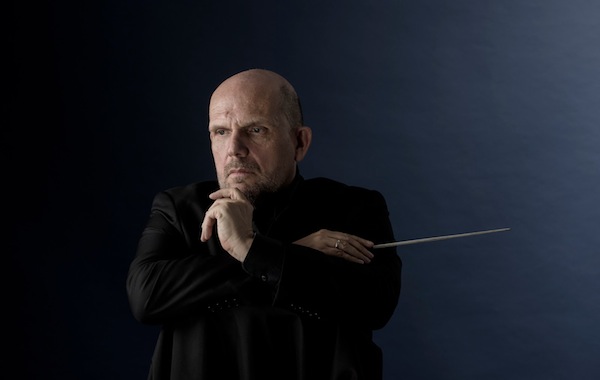With a last-minute Wotan, van Zweden leads DSO in a memorable “Walküre”

Jaap van Zweden led the Dallas Symphony Orchestra in a concert performance of Wagner’s “Die Walkure” Friday night. Photo: Wong Kin Chung
Jaap van Zweden’s penultimate program as music director of the Dallas Symphony Orchestra proved to be one of the finest moments of his decade-long tenure here, as he led the orchestra and an outstanding cast of singers through a concert version of Wagner’s Die Walküre Friday evening at Meyerson Symphony Center.
The drama wasn’t, however, entirely onstage. Ailing baritone Matthias Goerne, scheduled to perform the central role of Wotan, cancelled at midday Friday, around six hours before the curtain time of 6 p.m. One can reasonably assume a flurry of calls and arrangements ensued; just before the performance began, an orchestra official walked onstage to announce that American bass-baritone Kyle Albertson, currently preparing to serve as cover for that same role in the San Francisco Opera’s upcoming production of Wagner’s complete Ring Cycle, was at that moment still in flight from California and would arrive by 8 p.m. in time for the beginning of Wotan’s first appearance in Act II.

Kyle Albertson
Once onstage, while the rest of the vocal cast performed from memory and in formal concert attire, Albertson was a god in a dark business suit, frequently glancing at a vocal score placed strategically onstage. Other than that, it would have been hard to guess that Albertson had not rehearsed with conductor or singers, so convincing was his musical collaboration with van Zweden as well as his dramatic interaction with the rest of the cast.
This included the matrimonial bickering with Fricka (mezzo-soprano Christa Mayer) in Act II, and extended on to the intense emotionalism of Wotan’s farewell to Brunnhilde (soprano Heidi Melton) in the final scene. Fresh off the plane, Albertson husbanded his vocal resources throughout, in a role largely written to allow the singer to do so. He delivered a quietly dramatic presence in his monologue relatively early on in Act II; he gradually build up to the final scene three hours later in which he allowed his luxuriant tone quality to resonate at full volume before slipping gently into the mournful farewell aria “Leb’ wohl.”
Area audiences first became acquainted with Albertson as Doctor Bartolo in Fort Worth Opera’s 2016 production of Barber of Seville; this performance gave not only enthusiastically received testimony to his ability to perform magnificently in less-than-ideal circumstances, but a wonderful insight into his blossoming career as a first-rate Wagnerian.
Wagner was not so kind to Brunnhilde, calling on her to staat the evening at full power in Act II with the first announcement of the famous “Ride of the Valkyries” motif, with a good three hours to go. Fortunately, soprano Melton has a voice with the power of hurricane and a beautiful quality as well—and the ability to turn her thunderous volume down for heartrending delivery in quieter moments, as in the arresting unaccompanied recitative in Act III.
Dramatically, Melton’s finest moment arrived in Act III when she matched her vocal intensity with a frighteningly fine dramatic rendition of Brunnhilde’s transformation from a Valkyrie into a human woman caught in the center of a web of betrayal and conflicting loyalties.
Act I, of course, belongs to Siegmund and Sieglinde, in this case tenor Simon O’Neill and mezzo-soprano Michelle DeYoung. O’Neill owns a clarion-like Wagnerian tenor voice which loses neither power nor opulence even in the most intense moments; he held the high G-flat fermata and the immediately ensuing high G on the repeated declaration of “Walse! Walse!” in Act I to miraculous length, with nary a quiver.
DeYoung likewise demonstrated a perfect combination of richness and volume in her role, leading into her romantic aria “Du bist der lenz,” in which she carried her supple richness smoothly up to a high G-sharp. Together, O’Neill and DeYoung brought down the house in the final moment of Act I when they delivered, in the role of long-separated twins, the shocking, mouth-to-mouth incestuous kiss.
Bass Jongmin Park was vocally authoritative and convincingly jealous and evil as Hunding; mezzo-soprano Mayer as Fricka combined iron-willed sternness with fluid Wagnerian vocal power to cower Wotan. The ensemble of eight Valkyries, arrayed in two elegantly intimidating rows behind the bass section, were musically and emotionally perfect in their brief appearance.
In our age of constant digital special visual effects, a concert staging of Wagnerian music drama effectively evades the issue of the elaborate scenery and costuming which can detract as much as contribute to the Wagnerian experience. The placement of the Valkyries on the edge (and more or less within) the orchestra allowed their musical contribution to blend more organically with the orchestra; the same could be said for much of the other vocal performances, delivered oratorio-style in front of the orchestra, but with much more dramatic movement. The grandly symmetrical setting of the Meyerson Symphony Center set an aura that matches the music, while allowing the visual imagination of the devoted listener to provide the scenery.
Van Zweden and the massive orchestra (including six harps, two steer horns, and a bass trumpet, along with ) maneuvered through this demanding and lengthy score with steady expertise and unfailing momentum. The infamous “Ride of the Valkyries” at the beginning of Act III, interspersed with the shouts of the Valkyries, emerged with fresh and thrilling energy.
After the 6 p.m. start, the performance spread over five hours, including a 45-minute dinner break and a second 25-minute intermission. Van Zweden’s many skills include the ability, on full display here, to create an almost magical intensity in large-scale romantic works that makes time seem to rush by. This nearly final performance of his Dallas career reminded that he consistently communicates, as few other conductors manage, a sense of eventfulness and significance to the production of spectacular and massive works of this sort.
Die Walküre will be repeated 2 p.m. Sunday at Meyerson Symphony Center. 214-692-0203; mydso.com.


